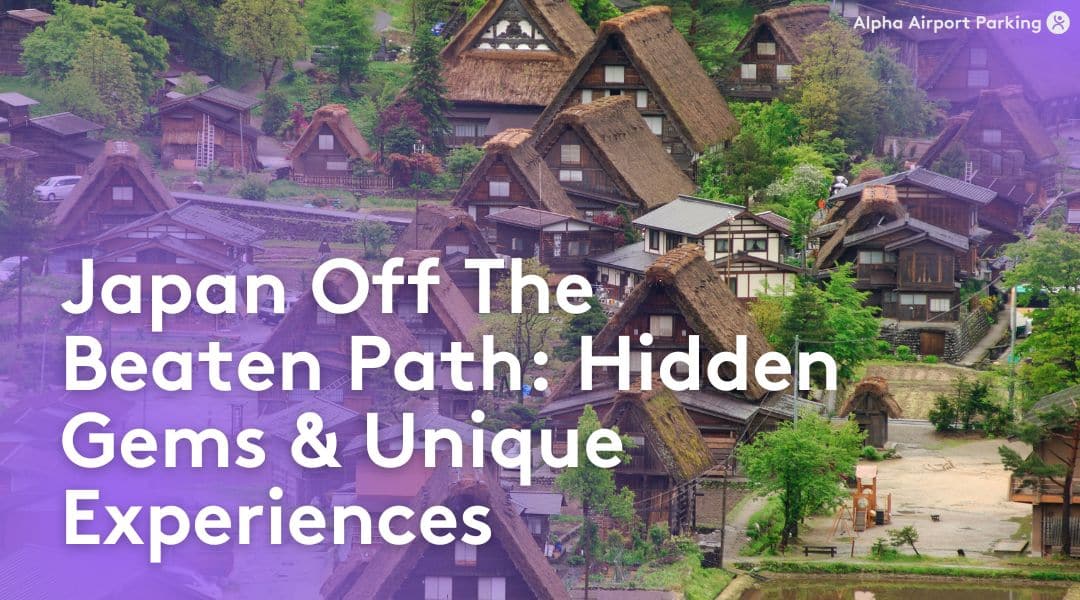Japan. A country of stunning contrasts, ancient traditions, and futuristic innovation. While Tokyo’s neon glow and Kyoto’s historic temples are undeniably captivating, what if you crave a deeper, more authentic immersion? What if you want to escape the crowds and discover the Japan few tourists ever see?
The so-called “Golden Route” encompassing Tokyo, Kyoto, Osaka, and Hiroshima is popular for a reason – it offers an incredible snapshot of Japan’s highlights. However, precisely because of their popularity, these major hubs can become incredibly crowded, especially during peak travel seasons. This can sometimes detract from the serene contemplation you might seek in a temple, or the genuine interaction you hope for in a local eatery.
The promise of venturing “off the beaten path” in Japan is that it reveals a profoundly different side of the country. Beyond the well-trodden tourist trails, you’ll uncover regions of serene natural beauty, towns where untouched traditions thrive, and communities where warm local hospitality is truly at the forefront. These unique cultural experiences offer a chance to connect with Japan on a more intimate level, away from the bustling tourist hordes.
In this guide, you’ll learn why choosing to go off the beaten path in Japan is such a rewarding decision, what kind of authentic experiences you can expect to find, specific regions and destinations to consider, and practical tips for planning such an enriching trip. And remember, even when exploring these lesser-known gems, secure Gold Coast Airport parking for your departure can ensure a stress-free start to your Japanese adventure.
Why Go “Off The Beaten Path” in Japan?
Venturing beyond Japan’s main tourist centres offers a wealth of rewards, transforming your trip from a typical sightseeing tour into a truly memorable and personal journey. It’s about peeling back the layers to discover the country’s authentic heart.
- Authentic Cultural Immersion: By stepping away from the “Golden Route,” you’ll find opportunities for genuine cultural immersion. You can experience local festivals (matsuri) and customs that haven’t been diluted or tailored for mass tourism, witnessing raw, unfiltered traditions. Staying in traditional ryokans (Japanese inns) in smaller towns often means experiencing family-run establishments where the hospitality is incredibly warm and personal. Locals in these areas, less accustomed to a constant stream of foreign visitors, may be more curious and openly welcoming, leading to unique interactions and insights. Furthermore, you’ll have the chance to discover regional cuisines and local sake varieties that are deeply tied to the land and its people, flavours that simply aren’t available in the major metropolises.
- Escape the Crowds & Find Serenity: One of the most immediate and tangible benefits is the escape from the throngs of tourists. This allows you to enjoy stunning attractions – be they ancient temples, vibrant gardens, or scenic viewpoints – without the jostling crowds, fostering a much deeper sense of appreciation and contemplation. You’ll find peaceful natural landscapes, tranquil temples where the only sound is the rustle of leaves, and quiet streets perfect for aimless wandering, offering a serene contrast to the urban bustle.
- Unique & Undiscovered Experiences: Japan’s lesser-known regions are treasure troves of unique and undiscovered experiences. This can range from encountering distinct forms of traditional art and craft to participating in specific regional practices that have been preserved for centuries. There are abundant opportunities for hands-on activities, such as learning traditional cooking techniques, trying your hand at indigo dyeing, or crafting your own pottery, offering a tangible connection to Japanese culture.
- Better Value for Money: Beyond the main tourist hotspots, the cost of travel often becomes significantly more affordable. Accommodation, dining at local eateries, and participating in activities can be notably less expensive, allowing your travel budget to stretch further or enabling you to splurge on more unique experiences.
- Supporting Local Communities: By choosing to explore off the beaten path, your tourism dollars contribute directly to the economies of smaller towns and rural areas. This helps to support local businesses, preserve traditional crafts, and sustain the unique cultural heritage of these regions, promoting more sustainable and responsible travel.
Regions & Destinations to Explore (Showcasing Diverse Experiences)
Japan is brimming with incredible destinations beyond its well-trodden paths. Here are some regions and specific locations that offer rich, authentic, and often serene experiences for the adventurous traveller.
- The Japanese Alps (Chubu Region): This mountainous spine of Honshu offers breathtaking scenery and a glimpse into traditional Japanese life.
- 1. Takayama & Hida Furukawa (Gifu Prefecture):
- Why: These beautifully preserved Edo-period towns are renowned for their traditional wooden houses, historic merchant streets, and vibrant morning markets. Hida Furukawa, a short train ride from Takayama, is often considered a quieter, equally charming alternative.
- Experiences: Spend hours strolling through the old streets, admiring the intricate architecture. Sample the exquisite Hida beef, a local delicacy, and visit traditional sake breweries for a tasting. Immerse yourself in local life by visiting the morning markets along the Miyagawa River in Takayama, or explore the beautifully maintained Takayama Jinya, a former government office. If your timing is right, participate in the lively spring or autumn festivals, which feature elaborate floats.
- 2. Shirakawa-go & Gokayama (Gifu/Toyama Prefectures):
- Why: These UNESCO World Heritage villages are world-famous for their unique gassho-zukuri (praying hands) thatched-roof farmhouses, designed to withstand heavy snowfall. They are stunning in all seasons, but truly magical when blanketed in winter snow.
- Experiences: Wander through the enchanting villages, visit the open-air museum in Shirakawa-go, and for a truly unforgettable experience, consider staying overnight in one of the gassho-zukuri farmhouses to immerse yourself in this ancient way of life. Don’t miss the scenic viewpoints that offer panoramic vistas of these architectural marvels nestled in the valley.
- 3. Kamikochi (Nagano Prefecture):
- Why: A pristine alpine valley nestled within the Chubu Sangaku National Park, Kamikochi is often hailed as the “Japanese Yosemite” for its spectacular mountain scenery. Vehicle access is restricted to protect the environment, meaning you arrive by bus, ensuring a peaceful atmosphere.
- Experiences: This is a hiker’s paradise. Enjoy a range of trails from leisurely riverside strolls to challenging treks up surrounding peaks. Revel in breathtaking mountain views, crystal-clear rivers, and serene forests. Explore iconic spots like Kappa Bridge (Kappabashi) and Myojin Pond.
- 4. Matsumoto (Nagano Prefecture):
- Why: Home to one of Japan’s most complete and beautiful original castles, Matsumoto Castle, often nicknamed “Crow Castle” due to its striking black exterior. It’s a designated National Treasure and serves as an excellent gateway to the Japanese Alps.
- Experiences: Explore the intricate wooden interior of Matsumoto Castle, climb to the top for panoramic views, and learn about samurai history. Wander through Nakamachi-dori, a charming merchant street with traditional buildings, and discover local crafts and galleries.
- 1. Takayama & Hida Furukawa (Gifu Prefecture):
- Tohoku Region (Northern Honshu): This northern region offers dramatic natural beauty, deep cultural roots, and a more rugged, less-visited charm.
- 1. Sendai & Matsushima Bay (Miyagi Prefecture):
- Why: Sendai is Tohoku’s largest city, vibrant and modern, serving as a convenient hub for exploring the region. Just a short train ride away is Matsushima Bay, celebrated as one of Japan’s “Three Most Scenic Views,” famous for its hundreds of pine-clad islands dotting the emerald waters.
- Experiences: Take a picturesque cruise around Matsushima Bay to fully appreciate the unique island formations. Visit Zuiganji Temple, a historically significant Zen temple, and the tranquil Entsuin Temple. In Sendai, explore the ruins of Aoba Castle, and indulge in the region’s excellent local seafood, especially the famous oysters (in season).
- 2. Ouchi-juku (Fukushima Prefecture):
- Why: A perfectly preserved Edo-period post town, Ouchi-juku transports you back in time. Its main street is lined with traditional thatched-roof buildings, many of which now house shops, restaurants, and inns. It’s famously known for its negi-soba, where you eat noodles using a large spring onion as a chopstick.
- Experiences: Stroll the historic main street, browse local crafts and souvenirs, and bravely try the negi-soba. Imagine samurai and merchants resting here centuries ago. The town is particularly beautiful in winter with snow.
- 3. Nyuto Onsen Village (Akita Prefecture):
- Why: Nestled deep within the mountains of Akita, Nyuto Onsen Village is not a single onsen (hot spring) but a collection of rustic, traditional ryokans, each with its own unique spring water. Famous for its milky white, mineral-rich waters.
- Experiences: Experience quintessential traditional Japanese hot spring bathing in a serene, natural setting. Each ryokan offers a distinct bathing experience, often with scenic outdoor baths (rotenburo). Consider staying overnight in one of these atmospheric inns for a truly authentic experience.
- 1. Sendai & Matsushima Bay (Miyagi Prefecture):
- Shikoku Island: Japan’s fourth-largest main island offers rugged nature, ancient pilgrimage routes, and a burgeoning art scene.
- 1. Iya Valley (Tokushima Prefecture):
- Why: One of Japan’s most remote and dramatic valleys, the Iya Valley is renowned for its steep, forested gorges, hidden hamlets, and iconic vine bridges (kazurabashi) that sway precariously over the emerald rivers below.
- Experiences: Challenge yourself by crossing the ancient, often thrilling, vine bridges. Explore the hidden hamlets and traditional farmhouses tucked away in the mountains. Take a scenic boat ride through the spectacular Oboke Gorge, admiring the dramatic cliffs and clear waters.
- 2. Naoshima & Art Islands (Seto Inland Sea):
- Why: Once quiet, rural islands in the Seto Inland Sea, Naoshima, Teshima, and Inujima have been transformed into unique contemporary art destinations, blending modern architecture and world-class art with the natural beauty of the islands.
- Experiences: Visit the architectural masterpieces and art collections of the Chichu Art Museum (housing works by James Turrell and Claude Monet) and the Benesse House Museum on Naoshima. Explore the numerous outdoor sculptures, including Yayoi Kusama’s famous pumpkin installations. Hire a bicycle and cycle between the art sites and charming local villages.
- 1. Iya Valley (Tokushima Prefecture):
- Kyushu Island (Southern Japan): Japan’s southernmost main island offers a blend of volcanic landscapes, vibrant cities, and lush sub-tropical nature.
- 1. Yakushima Island (Kagoshima Prefecture):
- Why: A UNESCO World Heritage site, Yakushima is a unique and enchanting island renowned for its ancient cedar forests, known as yakusugi, with some trees over 1,000 years old (the famous Jomon Sugi is estimated to be over 2,000-7,000 years old). Its lush, moss-covered landscapes are said to have inspired the magical world of Studio Ghibli’s Princess Mononoke.
- Experiences: Embark on unforgettable hiking expeditions through the ancient forests, ranging from easy boardwalk strolls to multi-day treks. Discover stunning waterfalls and immerse yourself in the primeval, misty atmosphere of this truly unique natural wonderland.
- 2. Kagoshima City & Sakurajima Volcano (Kagoshima Prefecture):
- Why: Kagoshima is a vibrant, subtropical city with a relaxed atmosphere, often compared to Naples due to its dramatic backdrop – the active Sakurajima volcano, which frequently emits ash plumes across the bay.
- Experiences: Take a short ferry ride to Sakurajima to get up close to the volcano, visit observation points (safety permitting), and enjoy the unique experience of a hot spring foot bath right on the volcano’s edge. Explore Kagoshima City’s beautiful Sengan-en Garden, a traditional Japanese landscape garden with views of Sakurajima.
- 3. Mount Aso (Kumamoto Prefecture):
- Why: Located in Aso-Kuju National Park, Mount Aso is Japan’s largest active volcano, boasting one of the world’s largest calderas. The vast caldera basin is home to towns, farms, and expansive grasslands.
- Experiences: Depending on volcanic activity and safety warnings, you might be able to hike around the Nakadake crater. Explore the scenic grasslands of Kusasenri, enjoy horseback riding, or visit local farms to sample regional produce. The surrounding area offers stunning panoramic views of the caldera.
- 1. Yakushima Island (Kagoshima Prefecture):
- Other Notable Off-the-Beaten-Path Gems:
- Kanazawa (Ishikawa Prefecture): A historic city often overlooked for Kyoto, offering Kenrokuen Garden (considered one of Japan’s three great gardens), beautifully preserved samurai districts (like Nagamachi), and atmospheric geisha districts (Higashi Chaya). It also boasts a vibrant contemporary art museum.
- Kumano Kodo Pilgrimage Routes (Kii Peninsula): A UNESCO World Heritage site, these ancient pilgrimage trails wind through beautiful, mystical forests and connect sacred Shinto shrines and Buddhist temples on the Kii Peninsula.
- Experiences: Hike sections of these historic trails, stay in traditional ryokans or shukubo (temple lodging), and experience a spiritual journey through Japan’s natural and sacred landscapes.
- Koyasan (Wakayama Prefecture): A sacred mountain centre of Shingon Buddhism, founded over 1,200 years ago. Famous for its atmospheric Okunoin cemetery, which houses the mausoleum of Kobo Daishi (Kukai), the founder of Shingon Buddhism.
- Experiences: Stay overnight in a shukubo (temple lodging) to experience monastic life, including morning prayers and vegetarian Buddhist cuisine (shojin ryori). Explore the vast and incredibly serene Okunoin cemetery, a truly unique and spiritual experience.
- Tottori Sand Dunes (Tottori Prefecture): Japan’s only major sand dunes, a surprising landscape that stretches along the Sea of Japan coast.
- Experiences: Walk across the impressive dunes, try sandboarding or paragliding, and visit the unique Sand Museum, which features intricate sand sculptures by international artists.





247 Comments
Comments are closed.